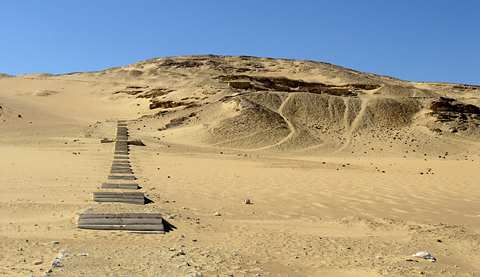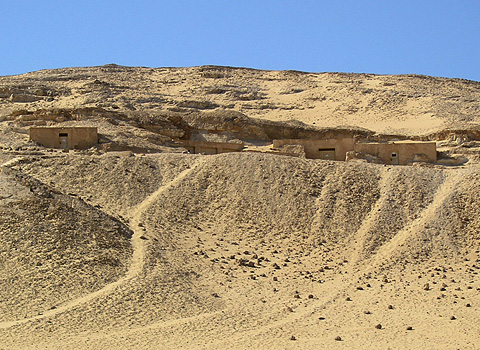Meir
Meir lies at the edge of the cultivation, about 50km north-west of Asyut. The modern town of el-Qusiya, about 8km to the east of Meir, probably derives its name from the ancient Qis, classical Cusae during Graeco-Roman times. Although Qis was capital of the 14th Upper Egyptian nome, there are few remaining traces of the ancient town. It was in the necropolis at Meir that the provincial rulers, or nomarchs of the region were buried in tombs high in the hillside, with the more humble population further down the slope.

Meir has had little archaeological attention since the tombs were first published by Aylward Blackman for the Egypt Exploration Fund in 1914 and then excavated by Sayed Pasha Kabasha in 1919. Reisner described model boats found at Meir and Daressy produced a study of the coffins. Since then the area has been fairly inaccessible to tourists but recently several of the tombs have been cleared and opened to visitors. The cemetery has many important rock-cut tombs dating to Dynasty VI and Dynasty XII, containing unusual painted scenes, characterised by their naturalistic qualities. Many of the tombs contain highly detailed scenes of daily life, including industries and sports and have a distinct local style.
Tomb of Niankh-hpepy (Meir A-1)
Niankh-hpepy was also known by the name of ‘Hepi the Black’ and his large tomb reflects his important status of Chancellor of Pepi I during Dynasty VI. The tomb contains four chambers. In the first and largest of these Niankh-hpepy and his wife are depicted receiving offerings of cattle, birds, animals and food and observing fishing and fowling, with the preparation of the catch. On the western wall of the tomb there is a stela with an offering slab in front. There are many shafts in Niankh-hpepy’s tomb, for the burials of his family.

Tomb of Pepyankh (Meir A-2)
Pepyankh was the son of Niankh-hpepy and was called ‘Heni the Black’. His tomb, which adjoins that of his father, is larger, and contains many scenes with details of industries and the harvesting of various crops, including grapes, grain and flax. On the left-hand wall of the western chamber are offering scenes which follow the owner into a long corridor and a room with a large burial shaft. On the right-hand wall Pepyankh is seen in a palanquin, shaded by a fan-bearer, accompanied by his pet dog and monkey in registers above. Another small offering chamber to the rear contains a false door. The central chamber (the first when entering the tomb) depicts the tomb-owner carrying out his duties, with scribes, secretary and attendants inspecting the workshops. The eastern chamber contains funeral scenes and a serdab with portrayals of the deceased on the walls.
Tomb of Senbi (Meir B-1)
This is perhaps one of the best known tombs at Meir. Senbi held the hereditary position of Nomarch and ‘Overseer of Priests’ during the reign of Amenemhet I of Dynasty XII, and his father was called Ukhhotep. His tomb contains many scenes of offerings, though some are now badly damaged, as well as agricultural and manufacturing scenes. The best preserved of the manufacturing scenes include vase-making. He is also shown in a spectacular desert hunting scene, accompanied by his dogs. At either side against the front walls of the chapel are two basins which would have been used during the offering rituals. A raised central aisle leads through the tomb to a statue niche at the rear.

Tomb of Ukhhotep (Meir B-2)
Ukhhotep was the son of Senbi (B-1) and held the hereditary titles of ‘Great Chief of the Nome’, ‘Overseer of Priests of Hathor of Cusae’ and ‘Overseer of Priests of the Lady of All’, during the Dynasty XII reign of Senwosret I. Reliefs in the tomb include scenes similar to those of his father, with offerings and marsh activities. A great variety of wildlife is depicted in hunting scenes in a lifelike and colourful manner. The tomb was apparently unfinished at the owner’s death and there are some figures which are roughly sketched in red paint. On the southern wall there are scenes of cattle whose herdsmen look emaciated, probably indicating a famine during this period. The paintings in this tomb are unusually vivid.
Tomb of Ukhhotep (Meir B-4)
Another tomb at Meir belongs to a man named Ukhhotep, a son of Ukhhotep and Mersi and he held similar titles of Nomarch to the previous Ukhhotep during mid-Dynasty XII. His tomb is a much more complex structure however, with a raised central aisle leading to a statue niche with an elaborate ‘palace façade’ decoration. The wall-scenes in the tomb are of similar themes to other Middle Kingdom tombs at Meir and include fishing and agricultural scenes, and industries. On the end wall on the left-hand side of the chapel the extended family of Ukhhotep are represented in seven registers. At the rear of the chapel to the right there is an offering chamber which contains texts of offering list rituals and a false door flanked by images of the tomb-owner.
Restoration of the tombs at Meir began in 1997 and several tombs have now had the walls consolidated and the reliefs restored to their original bright colours. At least nine of the tombs are open to visitors from a total of seventeen which are planned. New stairways have been constructed, making access easier, as well as a small coffee-shop and toilets. In the past the tombs at Meir have been prone to illicit digging as well as legal excavations, which at the time allowed the artefacts to be taken out of the country. Some of these have been returned and with many others are now on display in the small museum at Mallawi, including a limestone seated statue of Pepyankh and his wife from tomb A-2.
How to get there
The town of el-Qusiya is 50km north of Asyut, and around 25km south of Mallawi on the west bank of the Nile. From el-Qusiya a road leads west to the edge of the cultivation for about 8km to the necropolis of Meir. Visitors may buy tickets from the new ticket office at the site. Photography is not usually allowed inside the tombs.
